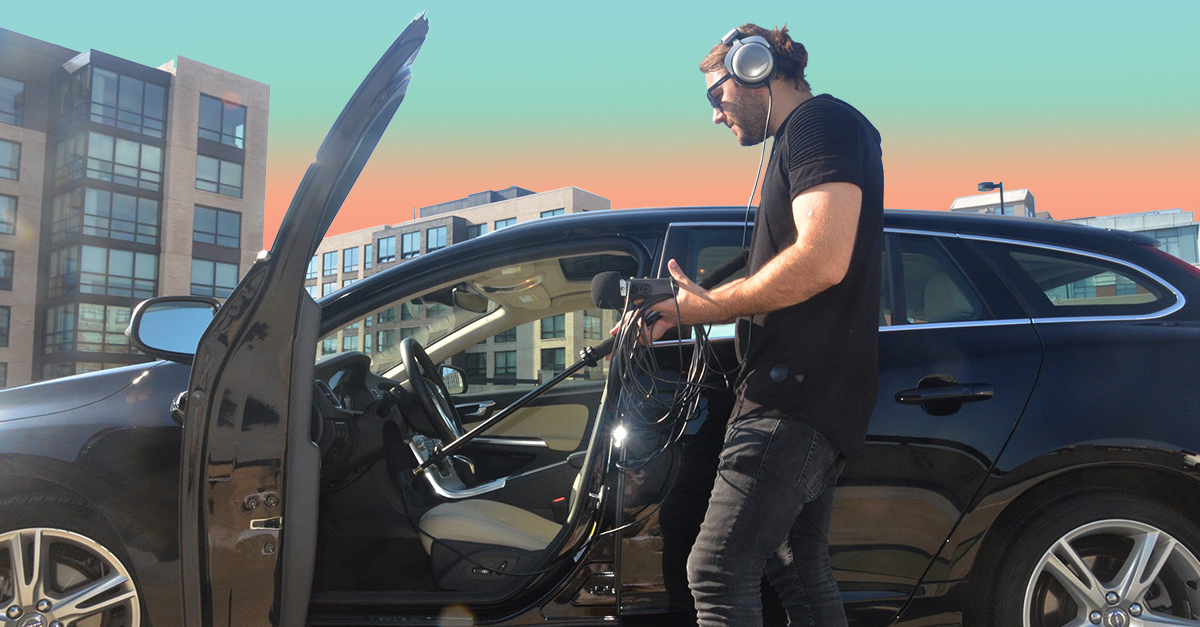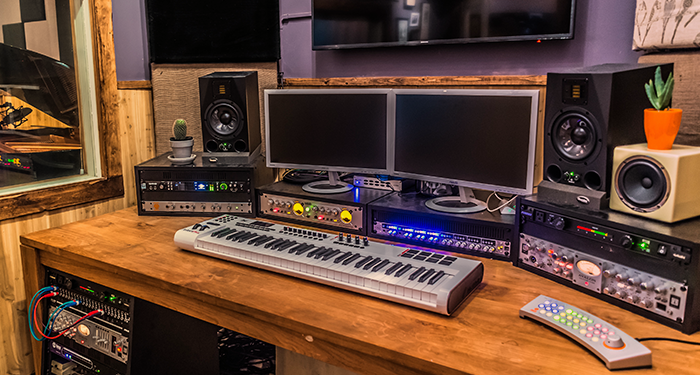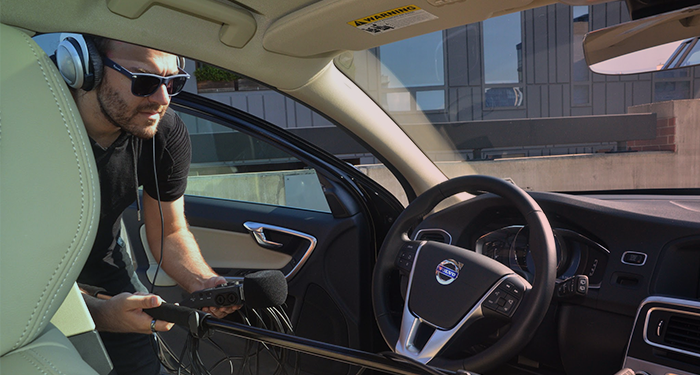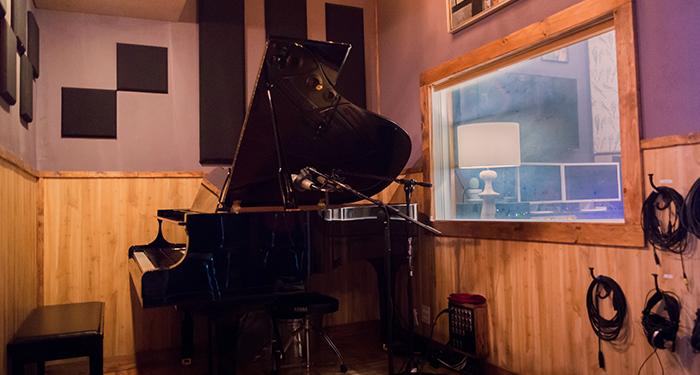
Audio UX is Building Better Experiences Through Sound Design

Music is hard to miss. It’s made to catch your attention, immerse you, entertain.
But traditional ‘music’ doesn’t account for all the audio we hear in the world. In fact, a huge portion of audio goes unnoticed despite its vital role in our everyday routines.
A newly received email in your inbox, an error message on your fitness app, even that telltale chirpy click letting you know that you’ve made a keystroke on your phone: It’s all audio too.
And like most audio—music included—it was composed by humans, in a studio not unlike any other studio.
In our current moment of mass ‘there’s an app for that’ thinking, the feedback, usability and connectivity that freelance audio gives to brands and products is more important than ever.
We routinely rely on sound to tell us when we’ve succeeded, when we’ve made a misstep, when to move on or what to do next. It’s audio built for user experience (UX), and it’s the novel side of sound creation that’s redefining freelance audio work.
New York based Audio UX—a ‘one-stop-shop creative audio agency’—understands the importance of the new and growing need for audio that connects.
Their sound work for brands ranges from foley and melody that communicates the functions of an app to fully realized compositions.
To shed a light on this new (but rapidly growing) field of audio, we spoke to the Audio UX team to find out how they’re building a world with functional sound, and how they’re adapting traditional studio techniques to fit the growing need for branded audio.
What does Audio UX do with sound?
At its simplest, Audio UX is a creative audio agency. We like to say that if you can hear it, we can do it. Our speciality is helping brands define their unique voice.
We develop custom-tailored audio aesthetics that are designed to create meaningful experiences for audiences and cultivate long-term cultural relevance through sound.
How does audio fit into a user’s experience and why is it important to have the right sound at the right time while using an app or website?
Audio fits into user experience by creating emotional context and providing functional feedback. We always seek to strike the perfect balance between using sound to articulate a brand’s unique voice and providing useful responses to the user.
Take the Google Assistant sound prompt for example—it embodies the minimal, intelligent, friendly personality of Google while functionally letting you know when it’s ok to start talking, when it’s thinking, etc.
To us, this is a great example of a well-designed sound for user experience. Without that sound, the experience of accessing the assistant via the UI can actually be confusing, because it’s often unclear through visuals alone whether or not the phone is actually listening.
We want to make all those experiences sound the best that they can.
This is why it’s so important to have the right sound at the right time. And while it’s key to design unique feedback where sounds are needed, it’s just as important to understand where silence should exist within a given experience. Much like visual designers, we—as audio designers—also value negative space in the same regard.
Determining when and where sound should exist will become even more important as more interactive experiences are developed, cars become more silent and voice controlled UI becomes more prominent. We want to make all those experiences sound the best that they can.
Branding today is predominantly visual work. With that in mind, how do you approach designing audio for brands?
For us, the first step in any engagement with a brand is to define their audio aesthetic: the guidelines and framework that allow anyone to understand what a brand sounds like.
The same way a branding agency creates a visual style guide that defines how to use a brand’s logos, colors and copy, we create an audio aesthetic style guide that defines what a brand’s instruments, genres, and unique branding points are.
Once we have that toolbox and foundation to build on, we strategize with the brand on unique opportunities where music and sound can elevate their content and be the driver behind social conversation. Our unique twist is that we try to combine a branding agency’s approach with the film scoring or album creation process. The goal at the end of the day is to give a brand a voice so powerful that people would want to listen to it on Spotify.

Do you believe audio is something that’s often overlooked when it comes to design?
Audio is often overlooked when it comes to design, so much so that the very founding of Audio UX was built upon a desire to raise the bar and challenge brands and designers to hold audio to a higher standard. In our experience within the advertising and product design worlds, we often here audio referred to as an “afterthought” within the creative process.
The goal at the end of the day is to give a brand a voice so powerful that people would want to listen to it on Spotify.
We want to showcase how powerful and effective audio can be when considered as a key component of the larger strategy from the beginning of the creative process.
So if audio shouldn’t be an afterthought, how can audio impact the visual and tactile elements of a product or a brand?
In good examples of audio user experience design, you see an effort being made to create auditory feedback that is not only functional but also contributes to the product feeling dynamic and “alive” via skeuomorphism, the concept of making something designed appear and function like it’s real-world counterpart.

To use Google as an example again, a good number of Google apps share a very consistent audio language that references the physical textures and surfaces upon which their material design visual aesthetic is built.
Hearing elements like office supplies, paper sliding across a table, pen clicks, and wooden taps lend the sounds a unique tactile element which creates a satisfying level of feedback to further immerse users. This not only lends a sense of realism to the experience but also strengthens the visual metaphor and ties strongly back to Google’s branding.
Can you talk us through some of the instrumentation and studio techniques behind some of the video work you’ve done?
MAC:
The fantasy piece was all about making the soundscape feel surreal. We did lots of heavy processing on otherwise fairly normal sounds to accomplish this. For example, the horse sounds are frequency shifted and have pitched granular delay on them.
There was also quite a bit of “abstract” visuals that we had to come up with sounds for. For those, we used recordings of Harry Bertoia’s Sonambient Sculptures, and MOTM modular sine waves that we ran through an old Eventide H3000, and an old ARP 2600.
Tiffany & Co.:
The Tiffany’s series was another beautifully shot project by our friend Mackenzie Sheppard, featuring Zhang Ziyi (Crouching Tiger, Hidden Dragon).
This was mostly an improvised score with piano and Prophet ’08. The piano was tracked on an August Förster at this practice studio in London while some of us were on tour. To most people’s surprise, the piano was recorded with just two 57’s.
But it’s a combination of the beautifully bright Förster and the Metric Halo (secret weapon) that make the recording shine. The pan spread on the Prophet worked great for the ambient swells that weave in and out of the piano. There’s also just a touch of FM mod to add a little haziness to the reveries. Overall, the vision was to have an emotional composition that scored the powerful tenor of the monologue.
TOTO:
The vision for TOTO was to evoke a sense of escape and wonder with the music. So creating a score that would transition from the tangible to the abstract was a cool concept to run with. We collaborated with German composer Nikolaj Egelund to open the piece with acoustic guitar and transitioned the piece into a more atmospheric landscape to capture the feeling like you’re mind is drifting away.
We develop tools and concepts together and then iterate as a unit in order to craft a strong articulation of our collaborative concept.
We used a Roland JX-8P to create the washy ambient pad and a Prophet ’08 PE for the sub-bass. The internal chorus on the vintage Roland is a definite go-to for building warm and hazy layers. The shuffling groove is a mixture of 60’s drum samples tracked from vinyl that was chopped up and pitched down to feel like being under water.
The drums and acoustic guitar create the sense of speed in the piece, kind of like your imagination is in a fleeting state. At the climax of the film, there’s a cool shot of the spiral water droplets shooting out from the head of a shower. To mirror this transcendent image, we used a mixture of sine and filtered square waves on the randomized setting of the Prophet’s arpeggiator.

What does audio bring to branding that nothing else can?
Imagine watching a Hollywood Blockbuster film without a score. Darth Vader wouldn’t be nearly as ominous without John Williams’ brilliant composition for “The Imperial March.”
Audio branding elevates a brand’s experience by giving it emotional context in the same way. We likewise use the art of leitmotif to create a world of sound for a brand to connect with their consumers. Audio and music evoke a level of emotional connection that people inherently understand and relate to. Our goal is to harness the power of that connection and give brands the tools to connect with their audiences on the same level that they connect with their favorite artists.
We see audio production becoming even more open and accessible with a shift towards creative content over technical prowess.
How do your tools and approach differ from other more common modes of producing like beatmaking or songwriting?
When a band or musician is creating a song for an album, they have complete creative control over the inspiration and direction of that product. When we set out to create an audio user experience, it’s always a collaboration between Audio UX and the brand. We have to obtain a deep understanding of a brand’s current positioning, demographic, and competitors before we can begin to plot the articulation of their voice.
We collaborate like a hive mind during branding initiatives. From the very onset of a project, we work closely together to conceptualize unique approaches and sound sources that we feel are completely distinct and align with project needs. We don’t use presets. We record unique source audio, often together as a team. We develop tools and concepts together and then iterate as a unit in order to craft a strong articulation of our collaborative concept.
How important are turnaround times when working with clients and how do you make sure audio creation can keep up with the visual aspects of a project?
Missing a deadline is never an option. We’re often working around the clock to get sounds into an app for product launch, scoring music for advertising campaigns, or launching a unique experience for audience engagement that’s tied to another brand activation.
Our value is our ability to integrate seamlessly at any phase of a project or strategy roll-out and elevate the audio without slowing down any other part of the process.

How does LANDR fit into Audio UX’s process?
We can’t deny the speed and uniformity LANDR provides to our team during the creative process, especially during our concepting phase.
We’re a boutique operation where the creatives are also running the business, so it goes without saying that we have somewhat limited resources and a lot of ground to cover.
We’re a boutique operation where the creatives are also running the business, so it goes without saying that we have somewhat limited resources and a lot of ground to cover.
Having a tool that not only instantly produces a “finished” sound but also creates continuity among 5 different composers’ mixes is really valuable for us.
In your view, how will audio production change most drastically in the next 10 years?
We see audio production becoming even more open and accessible with a shift towards creative content over technical prowess.
We’re embracing the future of autonomous mixing because it allows creators to focus on writing good music and getting it to a finished state more quickly.
As artificial intelligence continues to streamline workflows and starts replacing some of the more routine audio production jobs, we expect everyone’s creative output to only get better.
Hear (and see) all of Audio UX’s work on their website. Listen to Audio UX’s original music on Spotify and YouTube. Keep up with Audio UX on Instagram, Twitter and SoundCloud.
Gear guides, tips, tutorials, inspiration and more—delivered weekly.
Keep up with the LANDR Blog.


